Menu
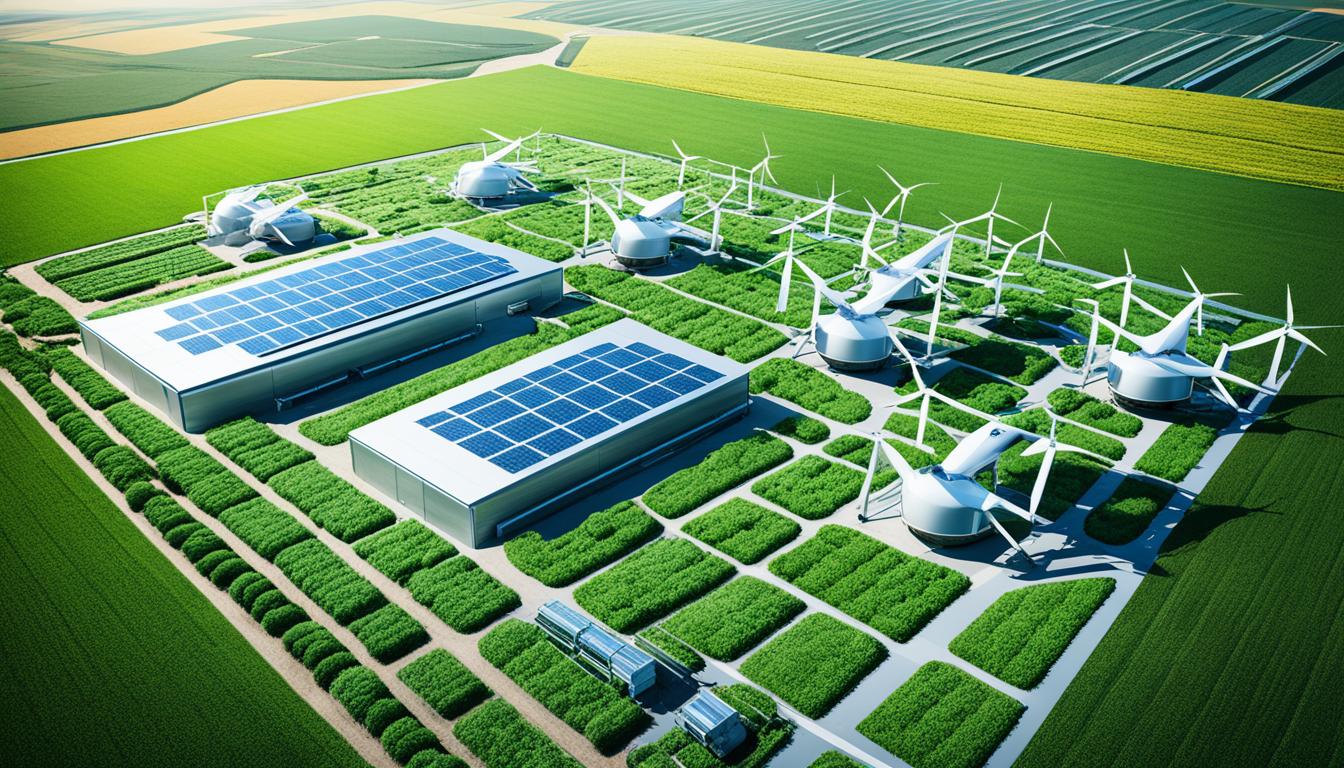
Did you know the global biotechnology farming market was worth a huge USD 38,918.85 million in 2022? It’s expected to grow by 9.38% yearly, hitting USD 66,646.82 million by 2028. This growth shows biotechnology farming trends and sustainable agricultural practices are more important than ever.
Demand for transgenic crops and synthetic biology products is boosting the industry. Top companies like Mycogen Seeds, Vilmorin, Syngenta, and Monsanto are leading the way. They use new methods that really change how the market works.
New technology like genetic modification and smart farming is full of potential for biotechnology. We’ll see big changes and new records in the industry as we learn more about these trends.
Biofarm trends are ushering in a new age for farming, where we rely on sustainable practices and the latest tech to feed the planet.
Biotechnology in farming uses science to improve plants, animals, and microorganisms. It’s very important for today’s agriculture. It helps crops resist diseases and addresses environmental issues. This makes modern farming better.
The biotechnology market in farming will grow to USD 69,932 million by 2028. This growth is needed to produce more food on less land. It also aims to fight the effects of changing weather on farming. Innovative farming technologies will help keep farming sustainable.
Biotechnology impacts farming in many ways, from changing genes to helping create helpful microorganisms. These methods improve the food we grow, make it healthier, and increase how much we produce. Using less harmful chemicals shows farming’s care for the planet and those who work the land.
Today, biotechnology creates plants that can grow in tough places, like salty soil or where it doesn’t rain much. This technology is key for food security and fighting climate change. In the U.S., most corn, cotton, and soybeans come from biotechnology.
Biotechnology also means we can use fewer chemicals on our crops. It makes farming easier and can produce better profits. This shows how important biotechnology is for farmers and the Earth.
The global market for agricultural biotechnology is set to grow. In 2023, it was worth $79.9 billion. By 2028, it’ll likely reach $119.6 billion, with an 8.4% annual growth rate. Biotech farming companies are driving this growth with new technologies.
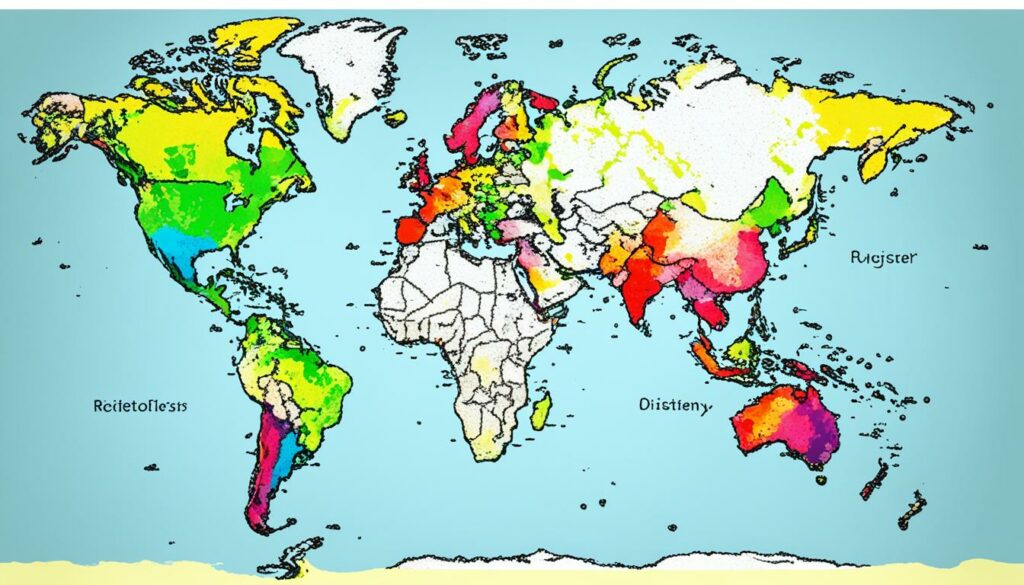
Companies like ADAMA Ltd., Bayer AG, and Corteva, Inc., are big names in the field. They’re known for innovation and smart investments. North America is a key market, thanks to its friendly regulations and GMO use.
BASF SE, Novozymes A/S, and Syngenta AG also make big contributions. They help set the scene for the industry.
Regions like North America and Europe are leading in this market. This is because they have friendly rules for GMOs. On the other hand, Asia-Pacific, including places like China and India, is growing fast. This growth is due to big investments and a need for new agricultural technologies. Latin America is second to them. Countries like Brazil and Argentina are using more biotechnology.
Here are some important figures:
| Region | Market Size (2023) | Projected Size (2028) | CAGR |
|---|---|---|---|
| North America | USD 95.74 Billion | USD 192.19 Billion | 8.05% |
| Europe | USD 69.23 Billion | USD 129.76 Billion | 7.5% |
| Asia-Pacific | USD 55.00 Billion | USD 112.83 Billion | 11.1% |
| Latin America | USD 45.69 Billion | USD 85.12 Billion | 10.8% |
| Middle East & Africa | USD 31.75 Billion | USD 42.67 Billion | 5.9% |
Some key factors driving the market are less arable land and the need for biotech crops. Plus, more money is being put into making agricultural technology better. It’s crucial to understand these trends to succeed in this fast-paced market.
Sustainable farming is becoming more vital in today’s world. It’s key to Europe’s plan to be climate-neutral by 2050. This strategy focuses on using eco-friendly ways in farming. It helps the environment, the economy, and people.
Using green methods in farming is crucial for nature and wildlife. The EU wants to cut down on harmful pesticides and grow more organically by 2030. This helps in the fight against climate change. Practices like changing crops every year and using less tillage are good for the soil and water.
Using fewer chemicals in farming is good for the planet. The goal is to use less dangerous pesticides and fertilisers by 2030. This is a big step for a greener future. It stops soil and water from getting too polluted. New methods in farming, like using friendly bugs and natural fertilisers, help keep the land healthy without as many chemicals.
| Goal | Target Year | Metrics |
|---|---|---|
| Reduce chemical pesticide use | 2030 | 50% |
| Increase organic production | 2030 | 25% of agricultural land |
| Plant trees in the EU | 2030 | 3 billion trees |
New technologies are changing farming. They are helping meet the growing need for food. These tools also help save resources.
By 2028, the market for precision farming is set to hit $16.35 billion. Smart farming, with technology like the internet of things (IoT) and sensors, is crucial. These tools help make better choices, use resources smartly, and increase harvests. Indoor farming, for example, uses 70% less water. It shows how precision farming can save vital resources. This matches the goals of smart agriculture.
Biotech diagnostics and new markers help the farming sector grow. These tools boost genetic enhancements and create disease resistance in plants and animals. With the global population heading towards 9.1 billion by 2050, we need 70% more food. So, these technologies are key to keeping growth sustainable. They help spot and manage plant and animal diseases. This leads to greater productivity and a steadier food supply.
Laser scarecrows, for instance, cut down bird numbers around farms by up to 90%. This shows how farming is getting better at protecting crops and increasing harvests.
| Technology | Impact |
|---|---|
| IoT in Agriculture | Projected to reach $33.57 billion by 2032, making resource management better. |
| Artificial Intelligence in Agriculture | Expected to grow from $1.7 billion in 2023 to $4.7 billion by 2028. It will improve choices and harvests. |
| Drone Technology | Expected to grow at a 20.7% CAGR by 2032. It will make farming practices more efficient. |
| Autonomous Tractors | Set to be a $3.29 billion industry by 2028. They will boost productivity. |
These advances in smart agriculture show just how much new farming technologies can change the future of farming.
Agricultural biotechnology has made great strides, especially with genetic modification. This method was first used in 1973 to create a genetically modified organism. It has since changed how we farm, making it more productive and sustainable.
The Flavr Savr tomato led the way in 1994 as the first GM crop approved for eating. Before that, in 1990, China introduced GM tobacco that resisted the tobacco mosaic virus.
By 1983, scientists had made tobacco and petunia plants able to withstand antibiotics. Today, we have Bt versions of cotton, corn, and potatoes that are popular for their ability to fend off pests and weed killers.
| Year | Milestone |
|---|---|
| 1946 | Discovery of genetic material transferability between species |
| 1973 | First genetically modified organism engineered |
| 1983 | Development of antibiotic-resistant tobacco and petunia |
| 1990 | Commercialisation of GM tobacco resistant to TMV |
| 1994 | FDA approval of the Flavr Savr tomato |
| 1995-1996 | Development of transgenic cantaloupe Charentais melons |
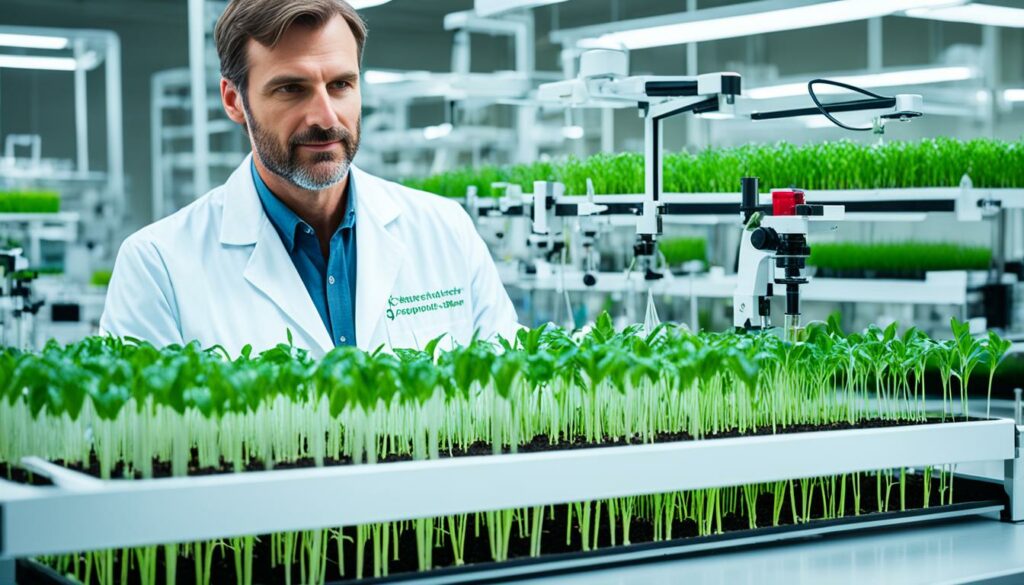
Genome editing, like CRISPR, is a vast leap in biotech. With these tools, we can edit a plant’s DNA very precisely. This can make plants better at resisting pests, more nutritious, and able to yield more food.
In 2012, most of the corn, cotton, and soybeans grown in the US used biotechnology. This shows the wide use and success of biotech crops in farming. These advancements keep improving our agriculture by making food production more sustainable.
Smart agriculture solutions are changing how we farm. They use new tech to make farming more efficient and productive. This helps meet the need for more food. The key is using IoT, sensor tech, and analytics.
IoT tech is a big deal in farming today. The use of IoT in agriculture is set to jump from $13.61 billion in 2022 to $33.57 billion by 2032. This fast growth is because of the use of sensor tech. It lets farmers keep an eye on things like soil moisture and temperature in real time. This means smarter choices and better use of resources.
Real-time monitoring through IoT and sensor tech significantly reduces water wastage and enhances yield predictions.
Europe is seeing precision agriculture grow to 62%. North America is close behind with 61%. This shows how quickly farmers are adopting IoT and sensors. By 2028, the sensor market in agriculture could be worth $3.1 billion. This shows how key these tools are for future farming.
Predictive analytics are another crucial area in smart farming. This tech uses big data to guess how crops will do and how to run farms better. It helps spot potential pests, bad weather, and crop issues. That way, farmers can plan ahead and take the best course.
Predicting and avoiding risks is super important with a growing population to feed. By 2050, we could have 9.1 billion people. Smart agriculture may reach $33 billion by 2027, and AI in farming could hit $4.7 billion by 2028. This would help farming be more efficient and productive.
With all these advancements, IoT, sensor tech, and predictive analytics are critical for agriculture today. They support sustainable farming, improve crop care, and boost food production. And they do this while helping the planet too.
In today’s farming world, precision farming methods are becoming more crucial. They boost efficiency and productivity using the latest technologies. With a 70% increase in global food demand expected by 2050, farmers need to use new methods. These methods can help keep up with growing needs without harming the environment.

GPS has changed how farmers map and analyse fields. GPS and GIS systems together provide accurate, real-time data on field conditions. This helps manage resources better and reduce harm to the environment. For example, RTK technology offers very precise measurements for farm equipment. This leads to healthier soil and better productivity.
Precision planting and seeding are key in precision farming. They plant seeds at the perfect depth and space, improving crop growth and yields. This method uses seeds more efficiently and uses the land better. Technologies like automated planters, drones, and robots make this process even smoother. They ensure every seed has the right start for growth.
Studies show the precision farming market could be worth $16.35 billion by 2028. This is thanks to a 13.1% annual growth rate. It comes as more people want efficient ways to monitor crops, with help from governments and technology. The future of farming will rely heavily on GPS and precise seeding. They are essential for meeting food demands in a sustainable way.
Molecular breeding is changing how we grow food. It combines farming and bioinformatics to make crops better. Małyska and Jacobi (2018) say it’s key for a sustainable future. They show the big move towards green farming.
Gomez-Casati et al. (2018) talk about how bioinformatics helps farming. They show us how new tech boosts farm productivity. Guo et al. (2013) found that adding specific enzymes to lettuce makes it richer in vitamin C and phenolics. This is biofortification, making crops healthier.
Li et al. (2022) prove we can make tomatoes with enough vitamin D. This shows biotechnology really helps make food more nutritious. Wang et al. (2020) made a tool to manage wheat’s genetic info better. This is key in modern agriculture.
Bioinformatics is a big deal in farming, as Esposito et al. (2016) tell us. Especially now, with so many people to feed by 2050. We must grow more food, deal with climate change, and match changing diets. Molecular breeding and bioinformatics are part of the solution.
| Study | Findings |
|---|---|
| Guo et al. (2013) | Enhanced vitamin C and total phenolics in lettuce via enzyme over-expression |
| Li et al. (2022) | Biofortified tomatoes for vitamin D sufficiency |
| Wang et al. (2020) | Established a web-database for wheat genome variation |
| Esposito et al. (2016) | Bioinformatics in Next-Generation sequencing era |
| Małyska & Jacobi (2018) | Highlighted plant breeding as a cornerstone of a sustainable bioeconomy |
By using these scientific advances, we can better our crops. They help us face the tough challenges ahead. This way, we are ready for the future, making farming sustainable for all.
Genetic engineering in crops has made big strides. It has helped create pest resistant GMOs and crops that can survive drought. These advances boost farming, ensure food is plentiful, and help against changing climates.
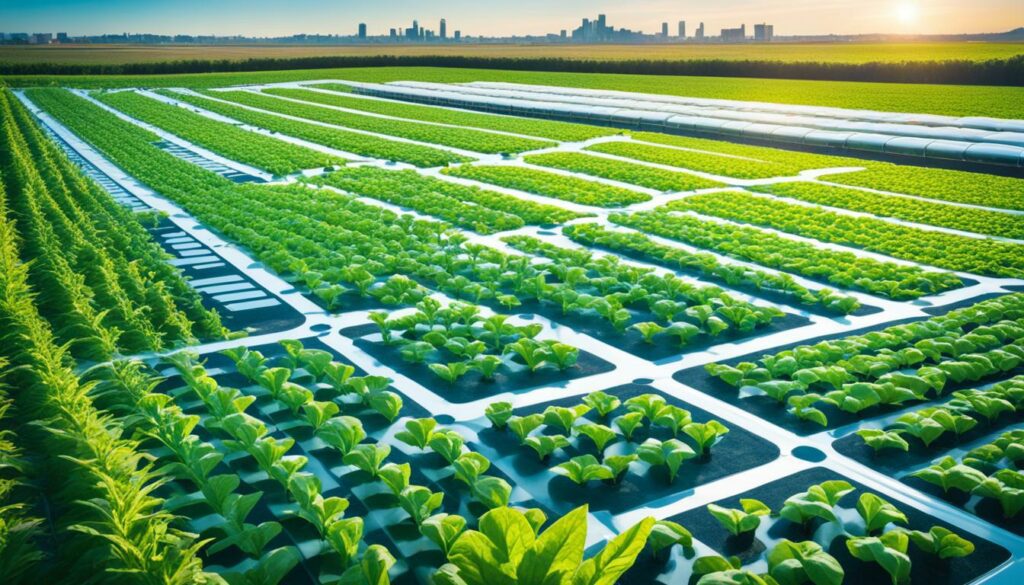
Take, for instance, genetically modified insect-resistant cotton. In 2012, about 94% of U.S. cotton was GMO. This change cuts down on pests without heavy pesticide use. It also increases how much cotton each field can grow. Similar success is seen with soybeans and corn that can withstand herbicides. These crops prove how critical genetic tweaks are for farming today.
Other great work is seen in making crops that survive droughts. With climate change causing more water issues, this work is crucial. Think of crops like maize and soybeans that can live through dry times. Starting from conventional methods, these crops go through strict checks to be safe. This safety check means these crops can be used widely without worry.
In brief, genetic engineering is key to solving big farm problems. It makes crops that resist pests and droughts. With these technologies, we can make sure there’s enough food and farming is strong against environmental pressures.
Tissue culture plays a key role in today’s farming. It’s used a lot to make copies of plants and keep their good genes. This way, we get healthy, even plants quickly.
This technology helps in many ways. It can save rare plants and make new ones that survive in tough conditions. It’s faster than regular farming, which takes a lot longer.
Other methods like mixing plant cells have also helped grow better crops. For example, mixing cells has made tobacco and others plants more able to fight off diseases. It’s a big help in farming.
Tissue culture has even made plants with just one set of genes for over 171 types. These plants include cereals and trees. It shows how tissue culture can help us grow more food in a smart way.
By using these new technologies, we can do better against climate change and feed more people. Tissue culture is a great partner for the future of farming.
The agricultural biotechnology market will grow from $79.9 billion in 2023 to $119.6 billion by 2028. Growth will happen at 8.4% every year. Several reasons contribute to this increase, such as less available land and more biotech crops. The amount of money invested in agricultural biotechnology is also rising.

In North America, the market is the biggest. Europe, Asia-Pacific, and Latin America and the Middle East & Africa follow. The U.S., Canada, Spain, Portugal, China, India, Brazil, and Argentina are important in these areas. Global agri-tech market developments are boosted by companies like BASF SE, Bayer AG, Syngenta, and Thermo Fisher Scientific Inc.
People are more interested in sustainable products, changing the market. Molecular diagnostics, markers, tissue culture, vaccines, and genetic engineering play a big role in agricultural biotechnology.
The market will have 28 data tables and 38 extra tables. In 2022, it was worth about USD 38,918.85 million. By 2028, it is expected to be worth USD 66,646.82 million. This means an expansion of 9.38% every year.
To sum up, biotech market trends show a growing market because of new technologies and consumer likes. These, with strategic alliances and premium goods, will shape the future of agri-tech markets.
Biotechnology farming faces big obstacles. It struggles because of tough laws and people doubting its value.
Biotechnology farming laws are tough. This makes it hard for new ideas to get off the ground. The rules can slow down the launch of cool new solutions for farmers. In some places, these new technologies just don’t fit. Plus, some leaders don’t give these new ideas enough support due to money problems and not fully understanding the science.
What people think about GMOs matters a lot. There are many worries about their safety and how they affect the environment and our health. This doubt can make people say no to new farming technologies. To help, we must talk openly and teach about the good and bad of GMOs. Also, making sure these new technologies are not too pricey is key, especially for small farmers.
Fixing these *biotech farming challenges* needs work from everyone. Businesses need to invest and update. But they must also think about what farmers really need. Experts suggest making sure these new tools match the local farming ways. This way, they can truly help.
| Biotechnology Farming Challenges | Explanation |
|---|---|
| Regulatory Hurdles | Stringent regulations slowing down GMO approvals |
| Public Skepticism | Concerns about safety, environmental impact, and health effects |
| Affordability | High cost of transgenic seeds for small farmers |
| Accessibility | Limited availability in developing countries |
The agricultural biotechnology sector is set for a big growth spurt. This is because there is a greater need for advanced breeding techniques. The use of biotechnology tools in farming is also rising. Big names in the field like Monsanto (now Bayer CropScience), Syngenta, DowDuPont, and BASF are leading the charge.
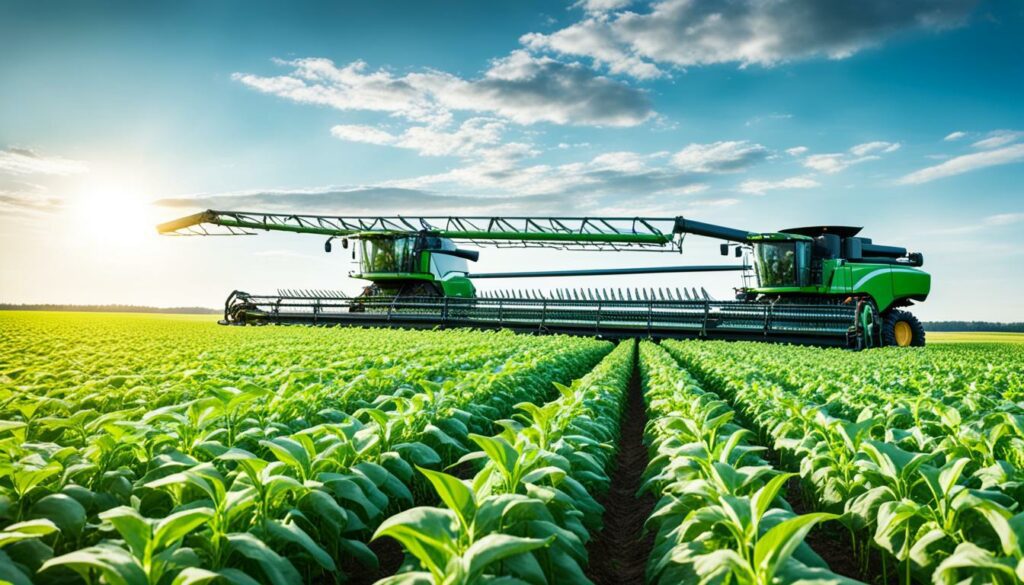
There are many areas to watch within this market. For example, techniques such as genetic engineering and breeding with molecular markers are key. These are used to improve our crops and help animals stay healthy. In places like North America and Europe, there is a lot of money being put into this area. The United States and Canada are leading here. Europe is also big, with many biotech companies and more use of GM crops.
In Asia Pacific, more people and less farmland are increasing the need for biotech. The Middle East is looking for ways to grow food more sustainably. In Africa, they’re using biotech to fight hunger. So, these areas offer huge chances for the biotech farming market.
Looking to the future, new genetic technologies are changing agriculture. More use of biotech crops and eco-friendly ways of farming are growing. Areas like precision farming and bigger investments in research look promising. This pushes the biotech sector towards a brighter tomorrow.
Exciting trends like gene editing and CRISPR are shaping the future. Also, how people and laws view biotech farming matters a lot. Things like fighting climate changes and making crops more resilient are top research areas. Working together on new tech is speeding up how fast we can use it everywhere. This is making the farming industry better at what it does.
The way people act towards biotechnology is quite complex. It’s mainly shaped by how much they know and the benefits they think they’ll get. With the biotech industry growing, it’s vital to get these aspects right to meet what consumers want.
Biotech products’ popularity among consumers is interesting. In the U.S., for example, only biotech foods very different from regular ones need special labels. This rule affects how biotech items are seen by the public and if they’re accepted.
A 2001 study looked at 172 people in the Midwestern U.S. They found out that those who got only anti-biotech info were less likely to buy biotech-labeled foods. On average, their bidding went down by 35%. But those who saw both good and bad sides of biotech bid 16 to 29% lower. This shows how getting the full picture changes what people think and do.
The want for biotech goods links closely with what people know and how clear labels are. Some say labels on biotech-food must be a must. They believe consumers deserve to know about bioengineering in their food. Foods labelled as ‘GM’ often get a 14% cut in price.
Plus, what people want on the labels themselves says a lot about what they expect. A survey in seven big cities found nearly half wanted for sure labels, not just optional ones. About 48.7% liked the idea of a special logo. And some 40.87% wanted the benefits of the technology shown in text. Only 10.43% were okay with logos on the main package view. These results tell us how varied consumers’ wishes are and how they affect the market’s need for biotech products.
Info from both sides deeply influences if consumers want to pay more for biotech foods. This highlights the need for open and fair ways of talking about biotechnology to change what consumers do.
The world of biotechnology farming is always changing. It’s driven by new methods and the aim for farm practices that last. Exciting technologies such as gene editing and molecular diagnostics are leading the way.
In 2012, roughly 88% of corn, 94% of cotton, and 93% of soybeans in the United States were genetically changed. These numbers show that biotechnology is well accepted in farming.
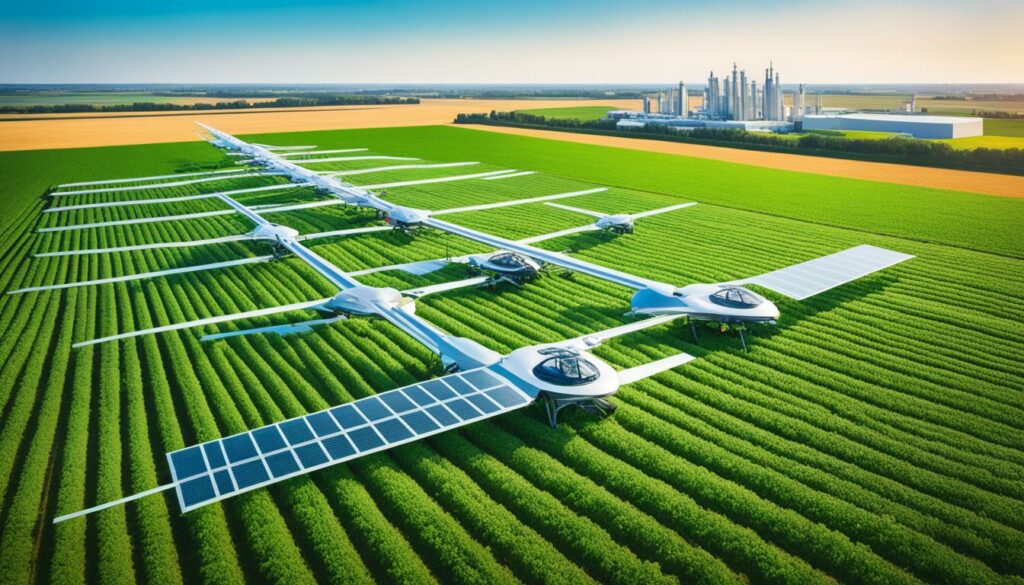
To farm in a way that doesn’t harm the earth, special crops are made. Crops like soybeans, cotton, and corn can survive certain herbicides but these weed killers break down fast and don’t hurt the environment. For instance, genetically edited papayas can resist a destructive virus, helping save the U.S. papaya business.
Groups like the USDA and the EPA make sure biotechnology in farming is safe and good for the planet. Their job is to check that using biotech meets high standards, which helps new farm technologies grow.
The trends shaping biotechnology farming today are:
Studies by groups like the International Service for the Acquisition of Agri-biotech Applications (ISAAA) show that biotech crops are a big part of farming worldwide. This suggests that biotechnology is becoming key to solve big farm problems globally.
My notes show that many countries are moving towards biotechnology in farming. This shift will help us produce more food but in a way that takes care of our planet. The progress of new technologies combined with careful rules offers a bright future for farming.
Agricultural biotechnology is growing fast. Its market size is set to jump from USD 79.9 billion in 2023 to about USD 119.6 billion by 2028. This means an 8.4% increase yearly. Transgenic crops and synthetic biology products are playing a big role in this growth.
In 2022, the global Agricultural Biotechnology market was worth USD 38,918.85 million. By 2028, it could reach USD 66,646.82 million. It’s rising at a rate of 9.38% each year. This growth is due to more biotech crops being used and increased investments. Mycogen Seeds is a key player, showing the industry’s vitality.
The future of biotech looks bright with high-tech tools like Molecular Diagnostics, Tissue Culture, and Genetic Engineering. Leaders like Bayer, Corteva, and FMC are driving these advances. They aim to make farming more productive. The use of IoT, sensors, and CRISPR tech is also changing agriculture.
North America leads in agricultural biotechnology. It’s followed by Europe and Asia-Pacific. A detailed industry analysis points out growth chances and hurdles. This helps companies plan ahead. With new tech on the horizon, the future of agricultural biotechnology is promising.
| Region | Market Size 2022 (USD Million) | Projected Market Size 2028 (USD Million) | CAGR (%) |
|---|---|---|---|
| North America | 15,000.00 | 27,000.00 | 9.38% |
| Europe | 12,000.00 | 20,000.00 | 8.0% |
| Asia-Pacific | 7,000.00 | 15,000.00 | 10.5% |
In conclusion, the biotechnology farming sector is growing and changing fast. It’s combining genetic changes, smart farming, and precise technology. This mix helps crops grow better and more sustainably, meeting the food needs of our growing world.
This field is using technology for local needs, making it more affordable everywhere. This is especially important in poorer areas, where farmers face unique challenges. For new tech like altered seeds to work, they need to fit local crops and weather.
Yet, challenges like rules, what people think, and where money goes are big. Private companies can focus more on selling products than helping small-scale farmers. But, the future is promising. New tech, gene editing, and growing up in buildings promise a future where food is plenty and good for everyone.
Reflecting on this topic, one thing is clear. We must keep investing and solving problems with smart ideas. By tackling both opportunities and problems, we build a stronger, successful farming future. Biotechnology farming is key to this, helping us move towards a brighter, greener future.
The main trends in biotechnology farming are new genetic methods and smart solutions. These include using CRISPR editing and smart systems. They make farming more efficient and sustainable.
In this market, strong companies like ADAMA Ltd., Bayer AG, and Syngenta lead. They use the latest technology to shape the future of farming.
North America and Europe lead due to friendly regulations on GMOs. Asia-Pacific is quickly catching up, making big investments in tech for farming.
Sustainable practices aim to be kind to our planet. Organic farming and less chemical use protect our water and soil, reaching for a greener future.
Today’s tech includes using sensors and IoT in the fields. It makes farming more precise and cuts down on waste, boosting how much we grow.
It’s about making crops more resistant using tools like CRISPR. This helps us grow more food with fewer chemicals.
IoT and sensors watch plants and soil closely, like a farm’s heartbeat. Farmers use this data wisely to make choices that lead to better harvests. This means we can grow food smarter.
They use GPS to plant crops exactly right, making sure they grow healthily. This saves resources and makes our farms more efficient.
They help pick the best traits for plants through genetics. This makes farming better by growing crops that are stronger and healthier.
It helps us grow food that fights off pests and survives in tough conditions. This is key to keeping our food supplies safe and stable, no matter the weather.
This technology makes lots of plants with the same good qualities. It’s a big jump for farming as we get better crops without diseases.
People want farming that’s good for the Earth. They also look for new genetic tricks to grow food in tough spots. These changes make our food more sustainable and safe.
It’s hard to get everyone to agree on using GMOs. Laws and what people think about GMOs make it tough. Open talk and learning are key to solving these problems.
There are many chances to grow. Investing in new tech and working together can make farming better. This helps meet the big hunger for food around the world.
What we choose to buy and eat affects how much farmers use biotech. Trust and what we want in our food influences these choices.
There will be more focus on gene editing and farming that cares for the Earth. Farming will keep up with new needs and wishes for food, making it better for everyone.
The future looks bright with farming tech growing fast. Businesses and leaders have to keep up with changes to keep feeding the world well.